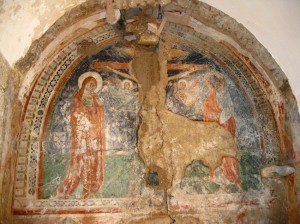 Builders working on the medieval church of Sant’Anna in Capri found a happy surprise behind a wall: a beautifully colored fresco dating to around 1300. The scene depicts the crucifixion of Christ with Mary and St. John on either side of the cross and a throng of heavenly host above. The image of Jesus himself is missing — not just deteriorated but a large section of the plaster appears to have broken off or been worn away — however, what remains is in very good condition.
Builders working on the medieval church of Sant’Anna in Capri found a happy surprise behind a wall: a beautifully colored fresco dating to around 1300. The scene depicts the crucifixion of Christ with Mary and St. John on either side of the cross and a throng of heavenly host above. The image of Jesus himself is missing — not just deteriorated but a large section of the plaster appears to have broken off or been worn away — however, what remains is in very good condition.
The builders found the fresco last July when they were buttressing the wall that covered it. A piece of the wall broke off and when they looked into the hole they saw a splash of color. The Sant’Anna restoration team decided to keep the discovery secret so they could work on conserving the piece without interference.
Under the supervision of Capri heritage expert and restorer Tina Dal Conzo and architect Rosalia d’Apice from the Culture Superintendency, builders first removed the entire wall that had been covering the fresco so that the painting could be properly conserved. The parish priest, Father Carmine Del Gaudio, has given the Superintendency permission to fully restore the painting and put it on public display.
Sant’Anna was built in the 12th century, and in its role as the primary parish church of the island it was where baptisms were done. It was named after Saint Anne, patron saint of pregnant women. It’s no longer consecrated today, so this find will doubtless be a welcome tourism draw.
Sant’Anna, which was until 1595 Capri’s main parish church, occupies a small building in the island’s medieval borgo. […]
The wall bearing the fresco also features late-Gothic decorations and geometrical designs from the same period, [Father Del Gaudio] added.
“The discovery of this work enriches Capri with another precious jewel, as testimony to its heritage dating back thousands of years”.
There’s some talk in the articles about the possibility of this fresco having been painted by the great innovator and master of the form, Giotto, but it’s based on, well, nothing. The colors used were in his palette, certainly, but in other artists’ as well. Other than that, the only reason people give for this glorious attribution is that Giotto did paint some frescoes in nearby Naples towards the end of his life. He lived there for 5 years, between 1328 and 1333, and Robert of Anjou, King of Naples and dedicated patron of the arts, named Giotto his “first court painter” in 1332, but the title and the pension weren’t enough to keep him down south. He soon left for Bologna and then returned to Florence where he died in 1337. (OMG Giotto died leet!)